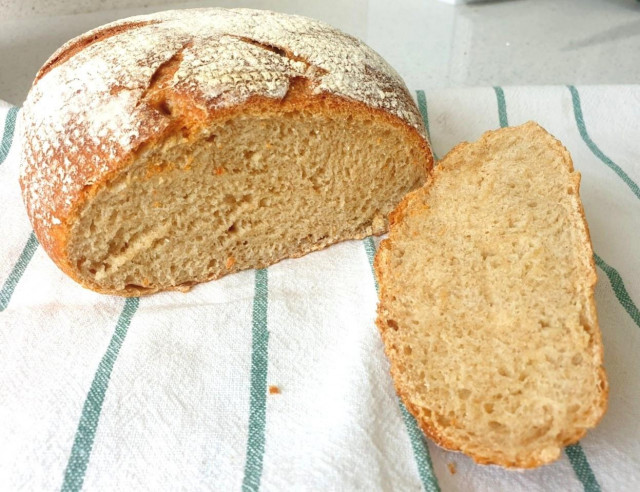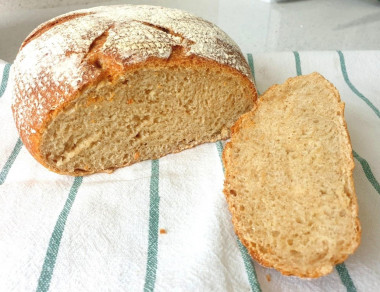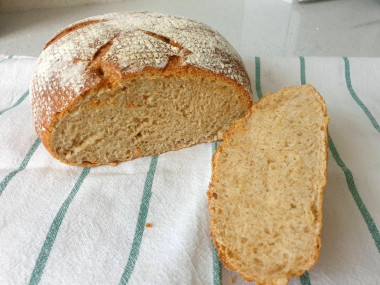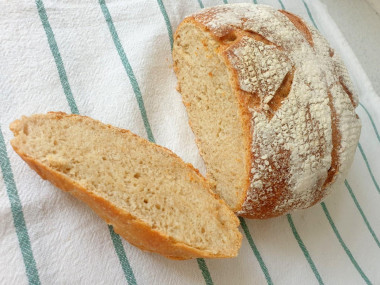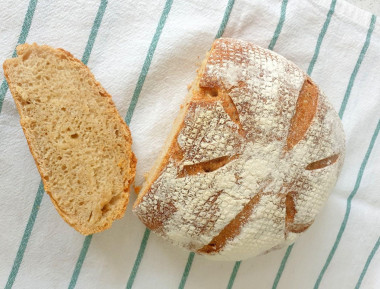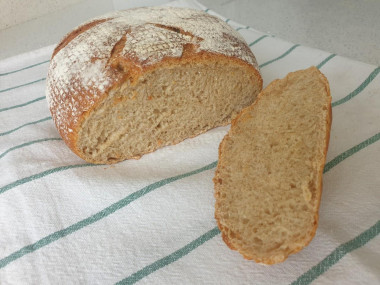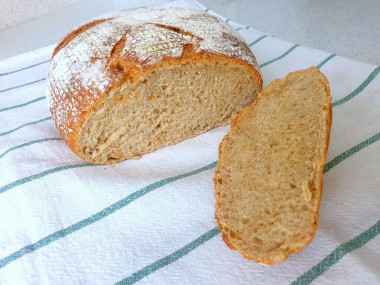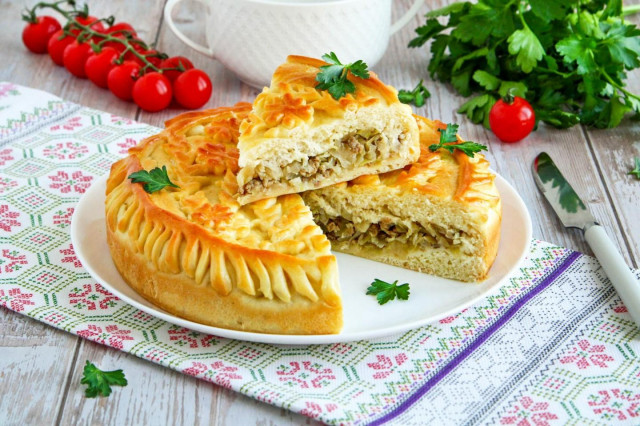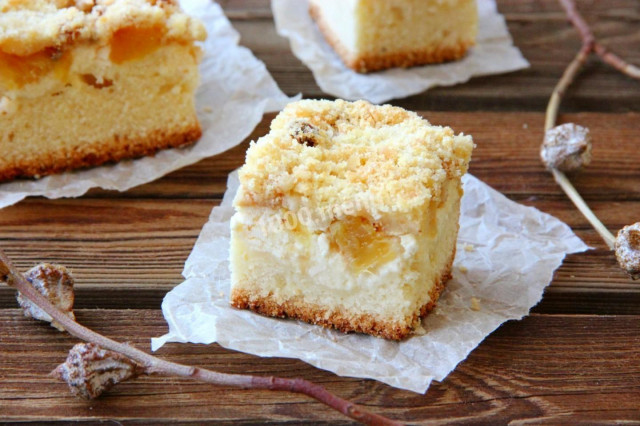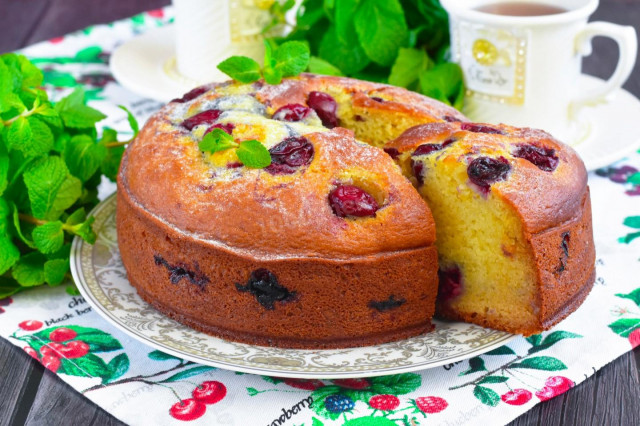Composition / ingredients
Step-by-step cooking
Step 1:
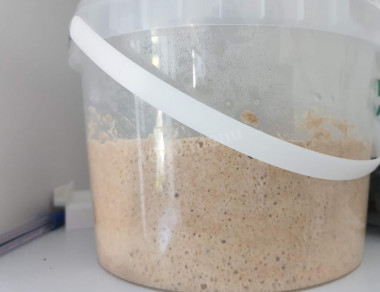
Preparatory stage: in the evening we put the sourdough (in fact, we revive the "eternal" rye sourdough, but feeding it with wheat flour). For details about the preparation and storage of the starter, read the description under the steps. For sourdough, I take rye eternal sourdough from the refrigerator, stir it in a container with water at room temperature and add whole wheat flour. I mix it, cover it loosely and put it away in a warm place until morning. By the morning, the sourdough will increase by about 3 times
Step 2:
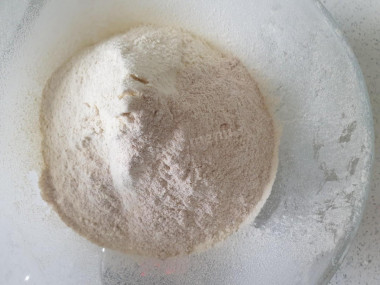
We begin to knead the dough. To do this, sift flour into a separate container, I have wheat grade 1, the dough behaves better with it when kneading because of the much larger amount of gluten. You can also use ordinary wheat flour of the highest grade, preferably not bleached. The taste of the bread will change slightly, but due to the addition of whole grain flour it will still be rich. Next, add whole wheat flour.
Step 3:
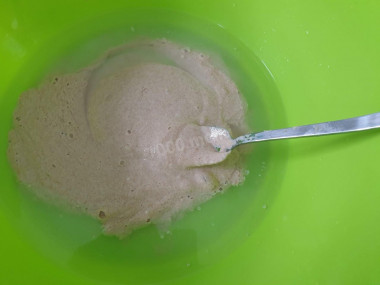
In another container (it should be wide enough and large enough for the convenience of mixing), add water for the dough at room temperature, put our dough into it and mix. At the same stage, add salt and sugar, mix until dissolved. If you use ground coriander, like me, then add it to the mixture and mix.
Step 4:
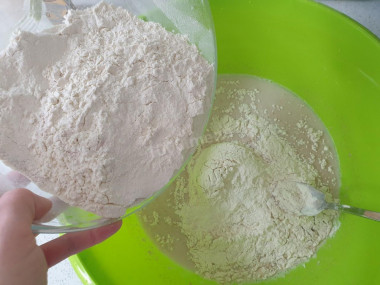
Add the flour in parts. Stir until possible with a spoon.
Step 5:
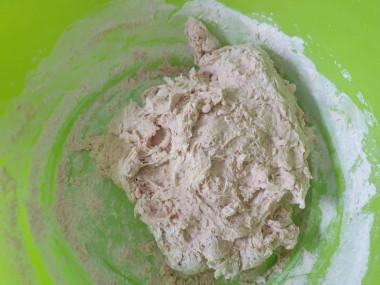
Then roughly knead with your hands. This process does not have to be long - just combine all the ingredients.
Step 6:
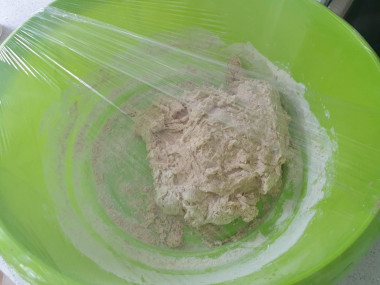
Now tighten the container with cling film and leave for 20 minutes for autolysis. Thanks to this procedure, the dough will become more plastic and smooth, and the baking will be lush.
Step 7:
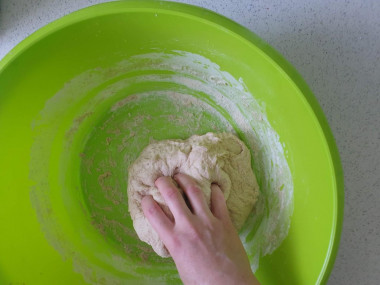
Knead the settled dough well. It should become plastic, gather into a bun and not stick to your hands.
Step 8:
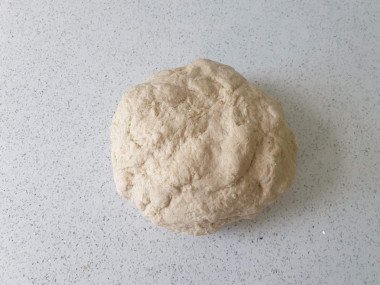
Place the dough on a lightly floured surface. My bun didn't stick to the countertop, so I didn't sprinkle it with flour.
Step 9:
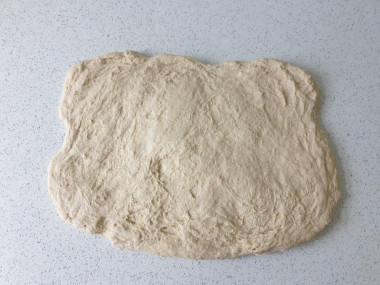
Now we need to perform an action called "stretch-fold". To do this, stretch the dough with your hands in different directions to get an approximate rectangle. Important! The dough is stretched, and not rolled out with a rolling pin into a layer.
Step 10:
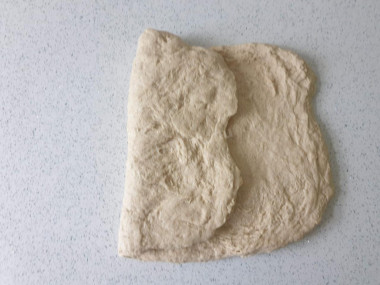
Mentally divide the rectangle into three equal parts. Now fold: first the left third to the middle.
Step 11:
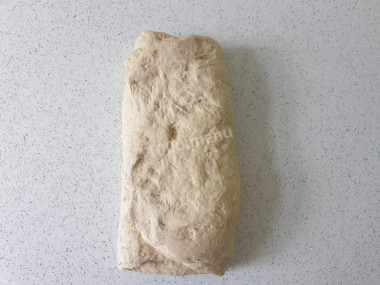
Then the right third to the center.
Step 12:
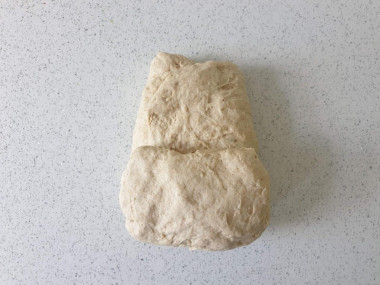
Do the same with the upper and lower parts, folding them to the center. Due to such simple manipulations, gluten is developed in flour, which improves the quality of baking. Our bread is sure to be lush!
Step 13:
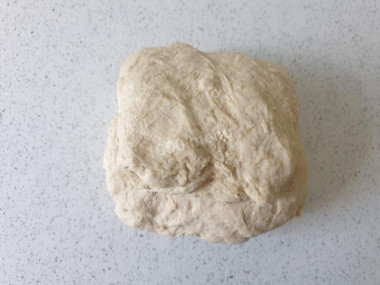
The resulting bun in any case, do not crumple! The difference between sourdough bread and yeast bread is that in yeast bread we periodically release gas bubbles, crushing the bread to speed up the fermentation processes, and in yeast-free bread all actions are aimed at preserving precious bubbles.
Step 14:
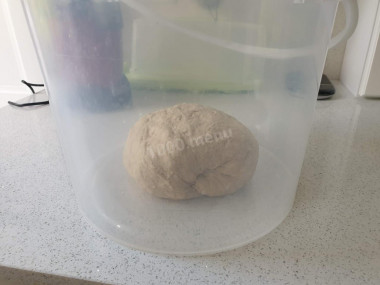
Put the dough in a container for melting (about 2 hours, but everything will depend on the temperature in the room and the strength of the starter, so the time may increase or decrease). The capacity should be large enough, as the dough will grow about 2-3 times. Tighten the container with cling film, or, as with me, close with an airtight lid. During the separation, repeat at least twice the "stretch-fold" procedure.
Step 15:
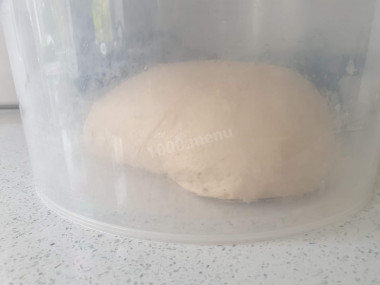
As soon as you see that the dough has grown noticeably in volume, you can proceed to the next step.
Step 16:
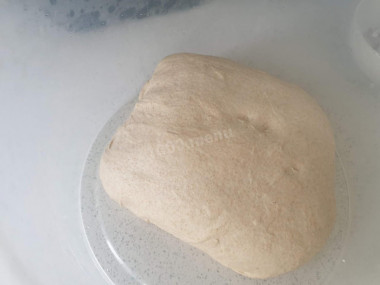
Remove the dough from the container and place it on the table surface.
Step 17:
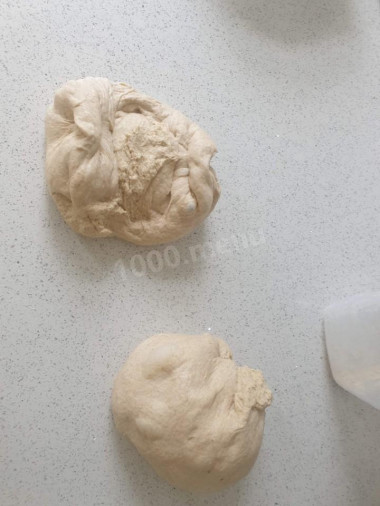
Divide into two parts.
Step 18:
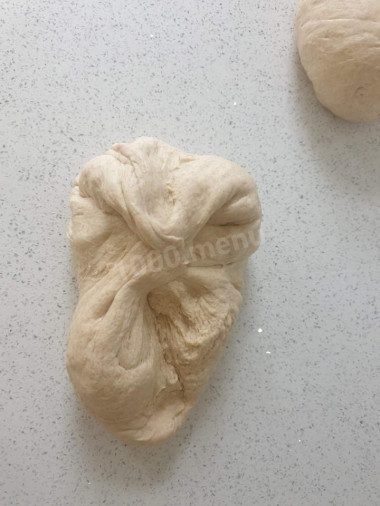
Stretch each part a little and gently bend the edges to the center. The next step will be forming bread, so now we are adjusting the dough to the future shape. There are special forms for such bread, but you can use any baskets, colanders, you can take a sieve of a suitable size. The main thing is that there are holes in the shape, since bread needs to "breathe".
Step 19:
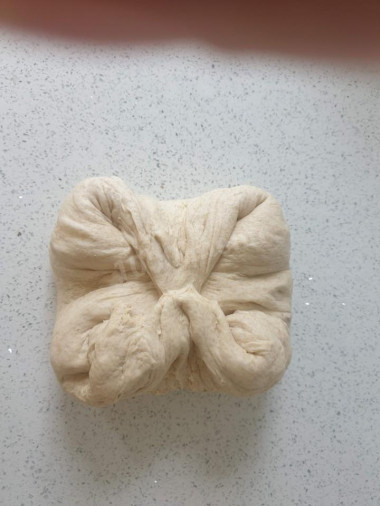
I bake round bread, shape it in two colanders. So I just bend the edges to the center. If, for example, your molding container is oblong and the bread will resemble a loaf, then the dough should be stretched into a rectangle and rolled into a non-rectangular roll.
Step 20:
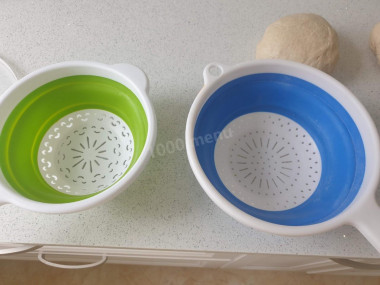
These are the colanders I have. One is bigger, so I left a piece of dough for him more.
Step 21:
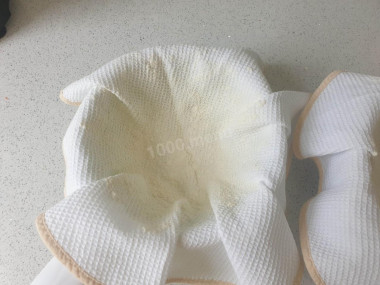
We line the molds with clean towels, be sure to sprinkle the fabric with flour so that the dough does not stick when standing.
Step 22:
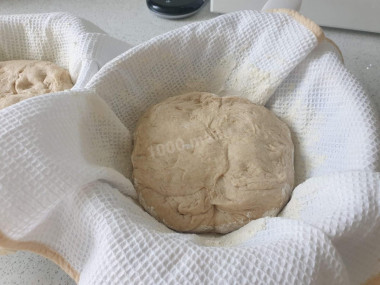
Put the prepared rounded blanks into molds, cover the top loosely with another towel. So the dough "breathes ", but does not wind up. Leave from 1.5 to 3 hours to part.
Step 23:
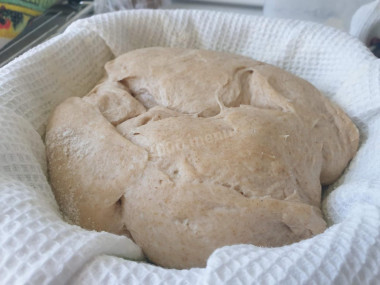
My dough stood for 2.5 hours. During this time, it rose 2-3 times and, with a slight pressure of the finger, it straightened up quickly enough (if the pit does not straighten back when pressed, then the dough has already stood). Turn on the oven at 240 degrees in advance, 10-20 minutes in advance. I set the mode "Upper and lower heat". Be sure to consider how you will make steam in the first 10 minutes of baking. I pour a glass of water on an empty baking tray at the bottom of the oven.
Step 24:
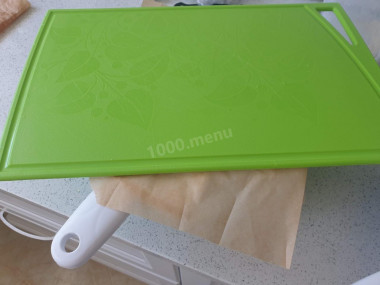
Now put a sheet of baking paper in a colander, a cutting board on top...
Step 25:
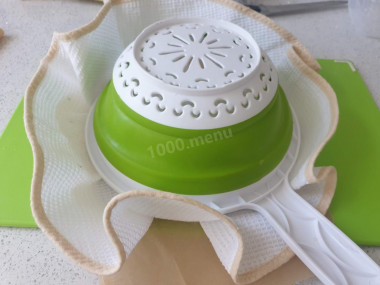
And, holding it, turn it over. The molded dough will be lying on paper, on a board.
Step 26:
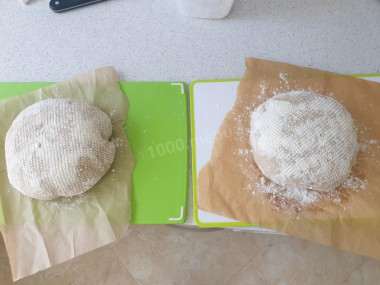
Carefully remove the mold (colander) and towel.
Step 27:
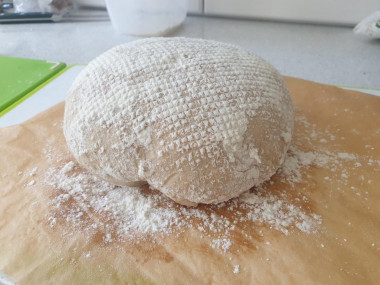
Here is such a rounded blank we got. Do not shake off the flour, otherwise the loaf may fall off.
Step 28:
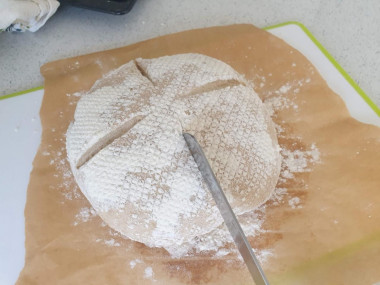
Now use a sharp knife to make incisions.
Step 29:
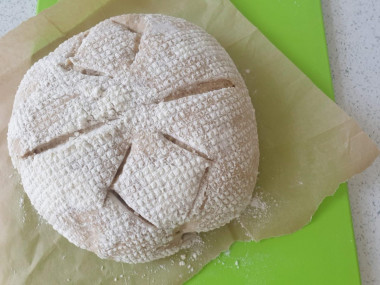
The drawing can be arbitrary.
Step 30:
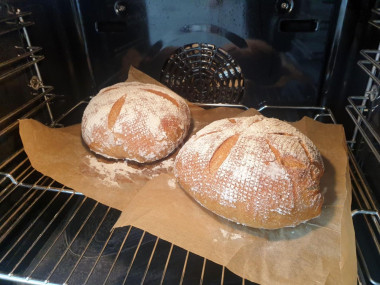
Now carefully move the bread along with the paper from the cutting board to the baking tray or grill in the oven. If you have a baking tray for water on the lower tier in advance, pour a glass of water into it (you can just put a container with water) Close and bake for 10 minutes with steam at 240 degrees, then open the oven for 5 seconds, releasing steam and bake for about 40-45 minutes without steam at a temperature of 200 degrees.
Step 31:
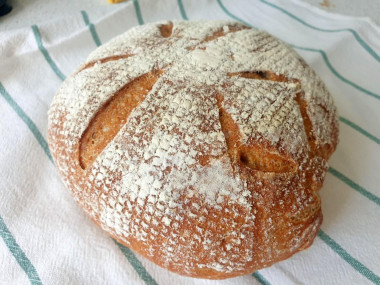
When the bread is browned, take it out of the oven! The wonderful aroma of homemade bread will fill your apartment. This bread is not called "white" in the usual sense. First-grade flour and whole-grain flour make its crumb more beige. But the taste is really amazing. Bon appetit!
The most difficult thing in this bread is to prepare a starter. To be honest, and it is not difficult to do. The main thing is not to be afraid and not to be lazy, because you will have to take out your first "eternal starter culture" for 5 whole days! Then it is safely stored in the refrigerator.
So, how to make rye sourdough for bread:
Day I
You will need:
50 g (about 5 tablespoons) rye flour,
50 g (about 5-6 tablespoons) water,
1 liter jar (the jar must first be thoroughly rinsed and scalded with boiling water).
The proportions of flour and water are approximate, the ratio of flour and water should be about 1: 1 – that is, one portion of flour for about the same amount of water. Mix flour and water in a jar. The consistency will be quite thick. Cover the jar with a cloth or cover it loosely with a lid so that the leaven breathes and let it stand in a warm place for 24 hours. Rye sourdough for bread without yeast will increase in volume during this time and the first bubbles will appear.
Day II
Half of the leaven of the previous day should be thrown away, and 50 grams of flour and 50 grams of water should also be added to the rest.
Now mix the ingredients and let stand in a warm place for 24 hours, covering the jar with a cloth or loosely lid. You will see that the number of bubbles is growing, and the smell is changing.
Day III, IV, V
Repeat the procedure every next day using the same proportions of flour and water. Before adding a new batch of flour, it is necessary to select half of the previous portion, and add flour and water in the same quantities as before.
On the third day, the rye sourdough will clearly increase in volume, will have many bubbles, its color will change and the smell will become more acidic. Sometimes you can even smell acetone, but this is not a sign of disappearing. On the third day, by and large, it is already possible to bake. However, it is better to wait until 5 days, ideally - until 6 or 7 days.
Every day the yeast-free starter will ripen more and more. On day 5, it will already be strong enough, and, in principle, you can start baking bread.
The ripened "eternal" sourdough is taken for sourdough according to the recipes of yeast-free baking, but the so-called starter is necessarily left, which is stored in the refrigerator. To do this, about 40 grams are taken from the leaven obtained on the 5th or 7th day into a separate container, 100 grams of water and 100 grams of rye flour are added. Stir and put in the refrigerator.
Such a starter is stored almost forever. But, regardless of how often or rarely you bake bread, the starter should be fed at least 1 time a week.
Feeding the eternal starter:
1. Remove the starter from the refrigerator
2. Put 40 grams of starter in a clean container, add 100 g of cold water and 100 g of rye flour. Mix it up.
3. The eternal rye sourdough is renewed and fed - immediately put it in the refrigerator.
By the way, we don't buy bread in the store anymore, so I bake it about 2 times a week. I update rye and wheat starter cultures with the same frequency.
Keep in mind that everyone's ovens are different. The temperature and cooking time may differ from those specified in the recipe. To make any baked dish successful, use useful information about the features of ovens !
Be prepared for the fact that you may need more or less flour than indicated in the recipe. Focus not on the amount of flour, but on the desired consistency of the dough. To avoid mistakes, read about flour and its properties!
Caloric content of products possible in the composition of the dish
- Salt - 0 kcal/100g
- Water - 0 kcal/100g
- Wheat flour - 325 kcal/100g
- Ground coriander - 25 kcal/100g
- Sourdough - 29 kcal/100g
- Whole wheat flour - 298 kcal/100g
- Sweetener - 20 kcal/100g

